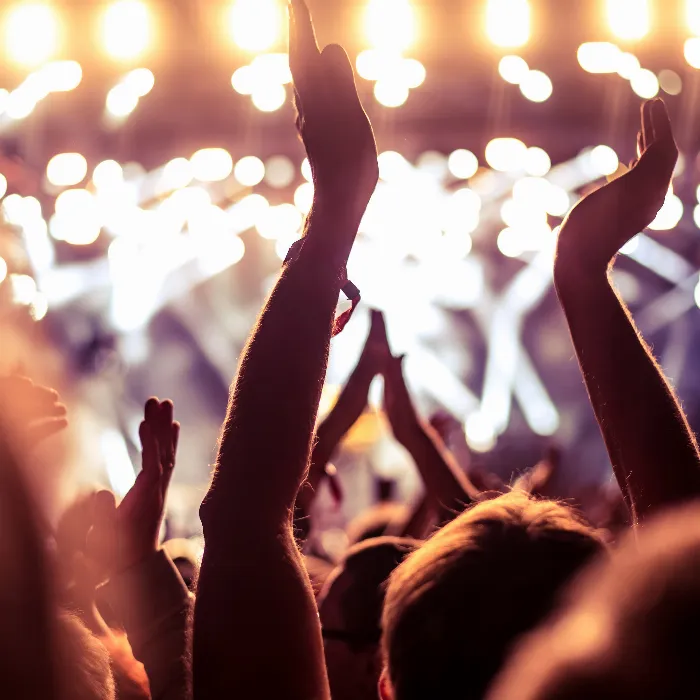Image composition (Part 1)
In my opinion, the conscious construction of the image composition cannot be memorized. The "golden ratio" and other image composition rules are attempts to explain why some photos stand out from the crowd; but they should not be understood as instructions to construct all photos according to these rules.
All the photo artists I know repeatedly emphasize that they create their images more or less unconsciously. Just "from the gut". If, on the other hand, you have to think for a long time while composing the photo (i.e. while taking it), you will miss the best moments (especially in concert photography).
Nevertheless, you should always give some thought to creative questions in between. And you should also keep asking yourself which of your photos stand out - because they are that little bit better than the others - and why: What is the small but decisive difference? If you ask yourself these questions regularly, you will also get a feel for effective image composition and improve in the long term. If you know about certain effects, you will then (unconsciously, trusting your gut feeling) take better photographs at the decisive moment.
Figure 7.1: The 80s cult ska band Madness (most famous "catchy tune": Our House) at their concert in the C-Halle in Berlin on October 24, 2012. It is not enough to just photograph well-known names in the music business. Artistic and creative composition, exposure control and focusing are all part of becoming a successful concert photographer. Canon EOS-1D Mark IV with EF 2.8/16-35mm using a focal length of 35mm. 1/50 second, Blender 4.0, ISO 1,000.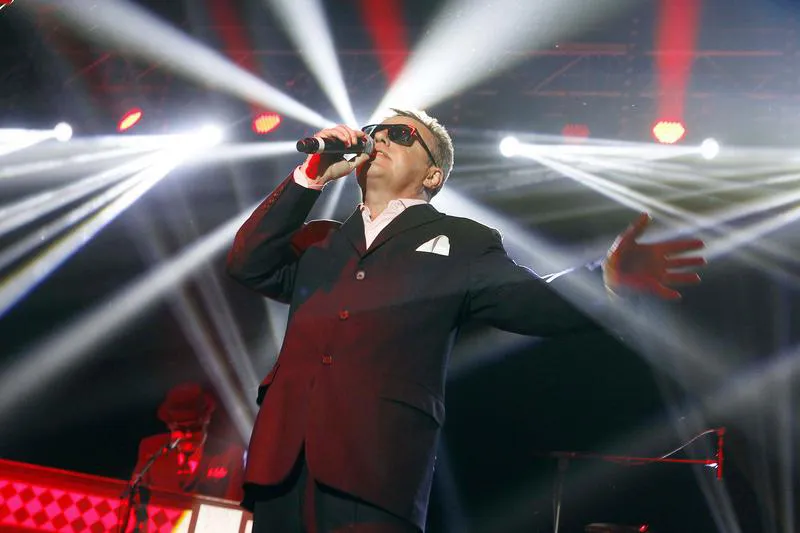
(Photo © 2012: DAVIDS/Sven Darmer - www.svendarmer.de)
7.1 Do not cut off the guitar neck
There are always some typical creative challenges in concert photography. Getting the guitarist and guitar right is one of them. Which image format is best suited to this subject? The portrait format with plenty of free space on the side, where the guitar neck requires little space? Or the landscape format, in which the artist's legs are not depicted? And sometimes the square format proves to be ideal, especially if the photo was taken at a slight angle, for example. However, you should avoid cropping the photos in a way that results in "non-formats"; these are formats that deviate significantly from the usual formats (3:4, 2:3, 1:1). When viewing such photos, the viewer will usually feel uncomfortable; they are simply "inharmonious" because they are unfamiliar (and also do not correspond to the usual way people see things and their need for visual harmony).
Figure 7.2: If the guitar neck is cut off in the photo (right), it looks kind of "stupid". It is better to include it completely, as in the photo on the left. Alternatively, you could have taken a square photo of the subject. Nikon D3S with 2.8/24-70 mm Nikkor at a focal length of 32 mm (left image) and 52 mm (right image). 1/250 second, Blender 2.8, ISO 5,000.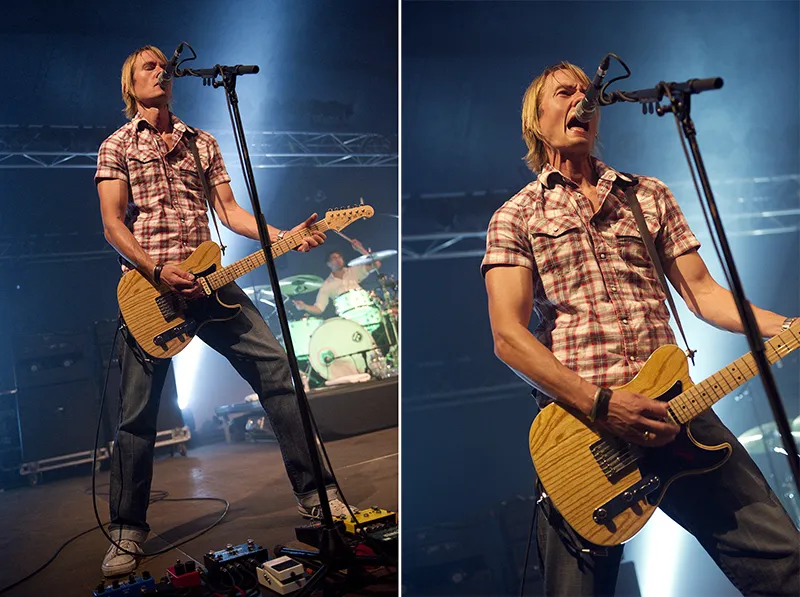
(Photo © 2010: Jens Brüggemann - www.jensbrueggemann.de)
Figure 7.3: I like to use the square image format for portraits of musicians (especially guitarists and drummers) because it allows me to cut off unnecessary space (stage background), which is often distracting. Nikon D800 with 2.8/70-200mm Nikkor with 185mm focal length used. 1/250 second, Blender 4.5, ISO 1,000.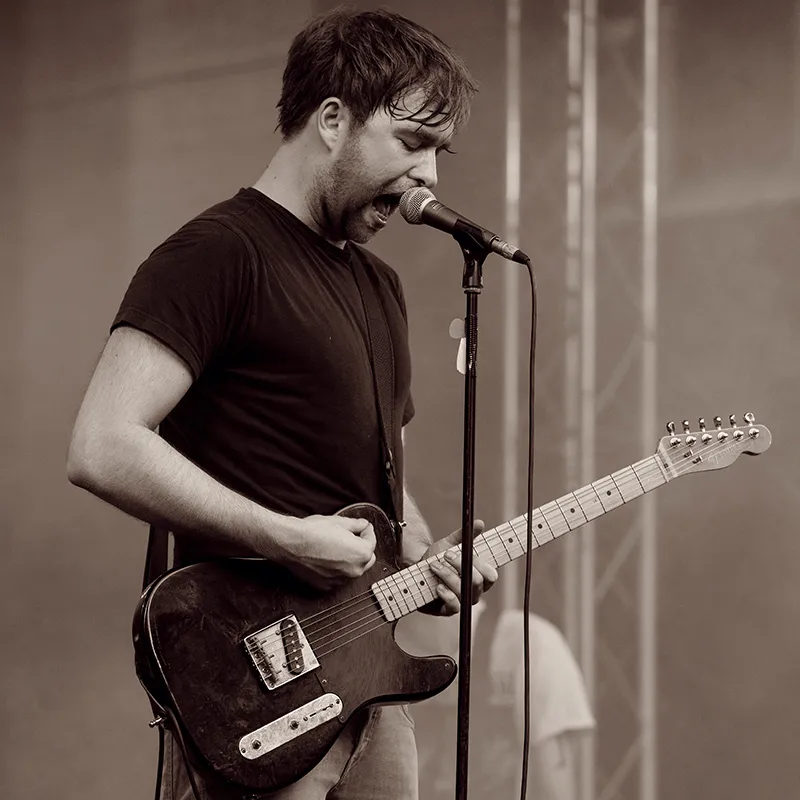
(Photo © 2013: Jens Brüggemann - www.jensbrueggemann.de)
7.2 The troublesome microphone
The microphone and microphone stand are objects that - depending on the shooting location and hand position - either obscure (sometimes large) parts of the singer's face or cast dark shadows on it. Both look unattractive in photos, and it is therefore also the concert photographer's job to choose a position that prevents or at least reduces this.
The fact that we usually photograph from below, from the press pit, looking upwards (towards the artists on stage), makes it clear that the problem of the microphone is exacerbated by this.
There are also hand positions where the singer's (or usually the rapper's) hand obscures the musician's face in such a way that a usable portrait photo cannot be taken. At least from a point of view that is frontal to the musician.
Figure 7.4: Here I was unlucky: due to the frontal spotlight, the frontal viewpoint (with a sideways view of the musician's face) does not produce satisfactory photos, because the shadows cast on the mouth and chin prevent the portrait from being considered successful (the shadows cast here virtually "disfigure" the artist's face).
Jan Delay at his concert on August 20, 2010 at the Zeltfestival Ruhr in Bochum/Witten. Nikon D3S with 2.8/24-70mm Nikkor at a focal length of 36mm. 1/2500 second, Blender 3.5, ISO 5,000.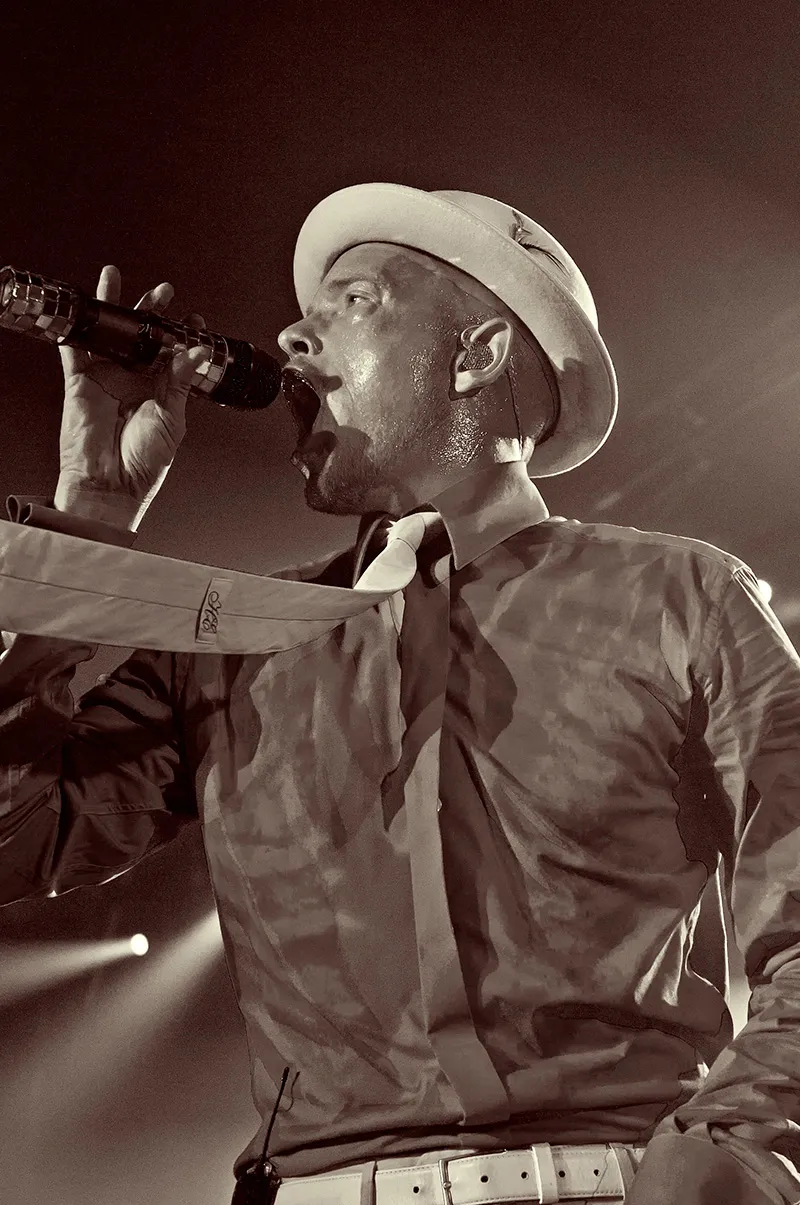
(Photo © 2010: Jens Brüggemann - www.jensbrueggemann.de)
Figure 7.5: The microphone and microphone stand always cause problems for us concert photographers. It often obscures too much of the face or casts unsightly shadows on the chin and neck of the artist. However, if the photographer positions himself at a slight angle in front of the singer (as in this photo), there are very few problems. But if you stand directly in front of him, the microphone covers far too much of his face. (For a better understanding, imagine with your mind's eye that the camera position in this photo would have been a little further to the left, so that the photographer would have been standing directly in front of the singer ... The frontal view together with the perspective from below, from the pit, would not have led to a usable result). Patrice & Shashamani Band in concert on November 17, 2005 in Berlin.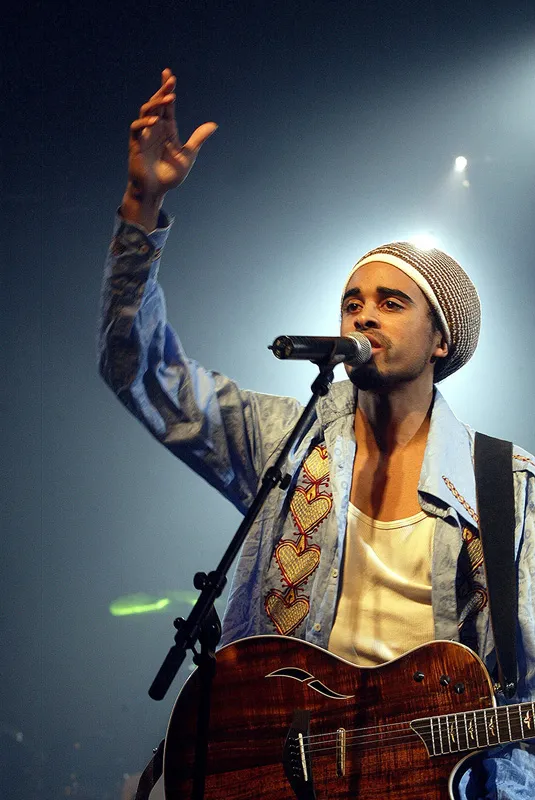
(Photo © 2005: DAVIDS/Sven Darmer - www.svendarmer.de)
It is then better to change the shooting location and photograph the singer more from the side, but still from the front.
Note: For singers holding the microphone with their right hand, it is best to photograph them from the front left (from the singer's point of view). If you were to photograph them from the front right (again from the artist's point of view), not only the microphone but also the artist's hand would cover his (or her) face. The same applies to left-handed singers, exactly the opposite.
Figure 7.6: For right-handed singers, the camera position diagonally to the left from the front is not so optimal, because in addition to the microphone, the singer's hand also obscures parts of the face (see left photo). A point of view to the right of the singer is then more advantageous. In the photo on the right, I was standing clearly to the right of the singer so that I could take a profile photo without the microphone getting in the way. Tim Bendzko in concert on August 24, 2012. Nikon D4 with 1.4/85 mm Nikkor. 1/400 second, Blender 3.2, ISO 3,200.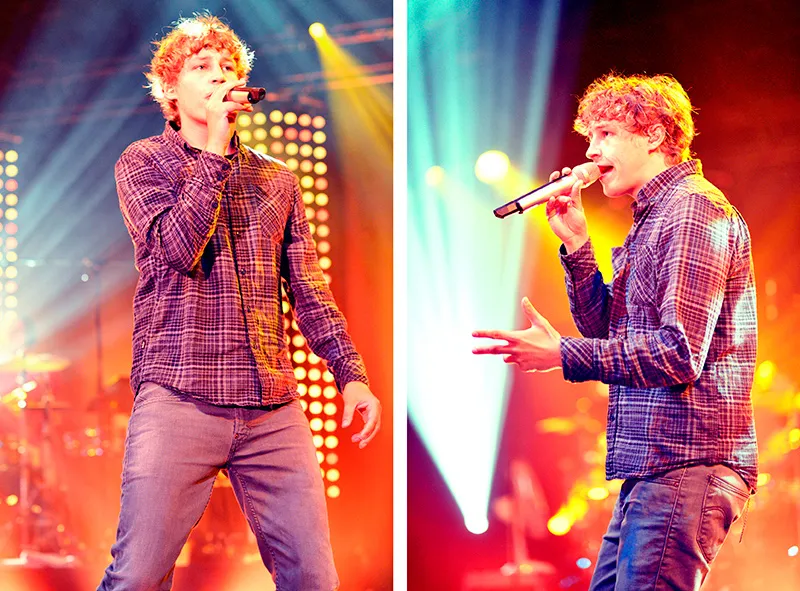
(Photo © 2012: Jens Brüggemann - www.jensbrueggemann.de)
Note: If you realize that the shooting position does not lead to optimal results, you should change it, even if this means losing valuable time. It is better to take fewer photos, but of better quality (in terms of image composition), than to take only mediocre photos.
7.3 Photograph details from time to time
Concert photographers usually only concentrate on photographing the (most famous) stars. At best, the band as a whole is photographed. From the point of view of the commercial-editorial use of the photos, both are perfectly correct. It is not the second or third row of artists that are in demand from the editorial offices, but only the best-known acts in the music business.
However, you can expand your sales opportunities enormously if you also take atmospheric photos of the action on and behind the stage and in the concert hall.
Detailed photos, for example of the instruments, are particularly suitable for publication in some (more neutral) form. Be it as a visualization of concerts in general, as a CD cover or generally as a symbol for music (corresponding to the musical instrument depicted). For example, an electric guitar embodies the worldwide known symbol for rock music.
Figure 7.7: Details sometimes say more than the "whole". In addition, they are often much easier to "silver" because they can be used more universally than portraits of musicians (although not in the editorial section, where portraits of musicians are naturally more in demand than abstract detail photos). Nikon D3S with 1.4/85 mm Nikkor. 1/160 second, Blender 2.2, ISO 1250.
(Photo © 2011: Jens Brüggemann - www.jensbrueggemann.de)
7.4 Capturing the artists' facial expressions
Concert photography is action photography. Photos of a brilliant show and acrobatic dance routines are just as much in demand as atmospheric shots with great lighting effects in the background. Nevertheless, good photographers should also make sure to capture the facial expressions of the performers involved, as these often tell more than a thousand words.
Figure 7.8: "Oooops ... Did I just make a mistake?" the guitarist at the Bochum Total festivalseems to be asking himself. Capturing the facial expressions of the artists is what makes concert photography varied and interesting. It would be bad and boring if all the musicians at their concerts just stood on stage looking cool and disinterested. Nikon D800 with 2.8/70-200 mm Nikkor. 1/500 second, Blender 4.5, ISO 800.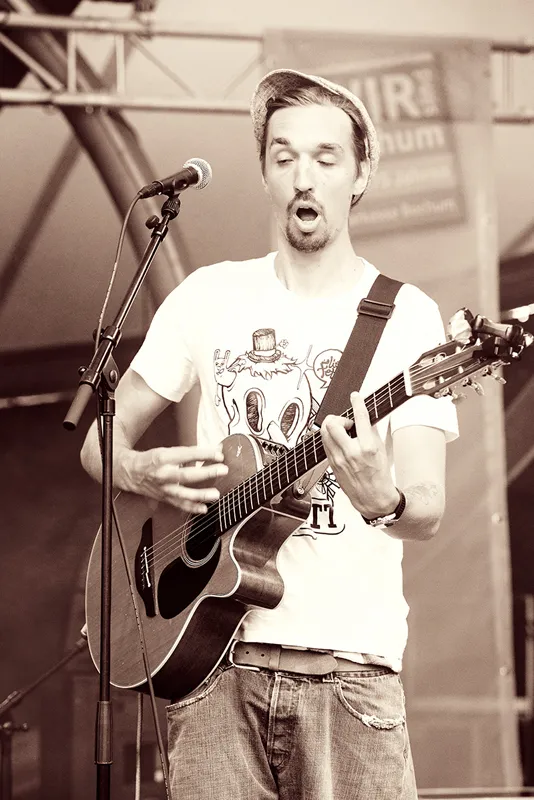
(Photo © 2013: Jens Brüggemann - www.jensbrueggemann.de)
Genuine joy and enthusiasm at being greeted by the fans, concentrated guitar playing, a relieved facial expression or enthusiastic absorption in the music are all moments that are worth capturing photographically.
Figure 7.9: The fervor with which Cecilia Bartoli (here at the Philharmonie concert in Berlin on November 17, 2007) performs can be seen quite clearly in this snapshot.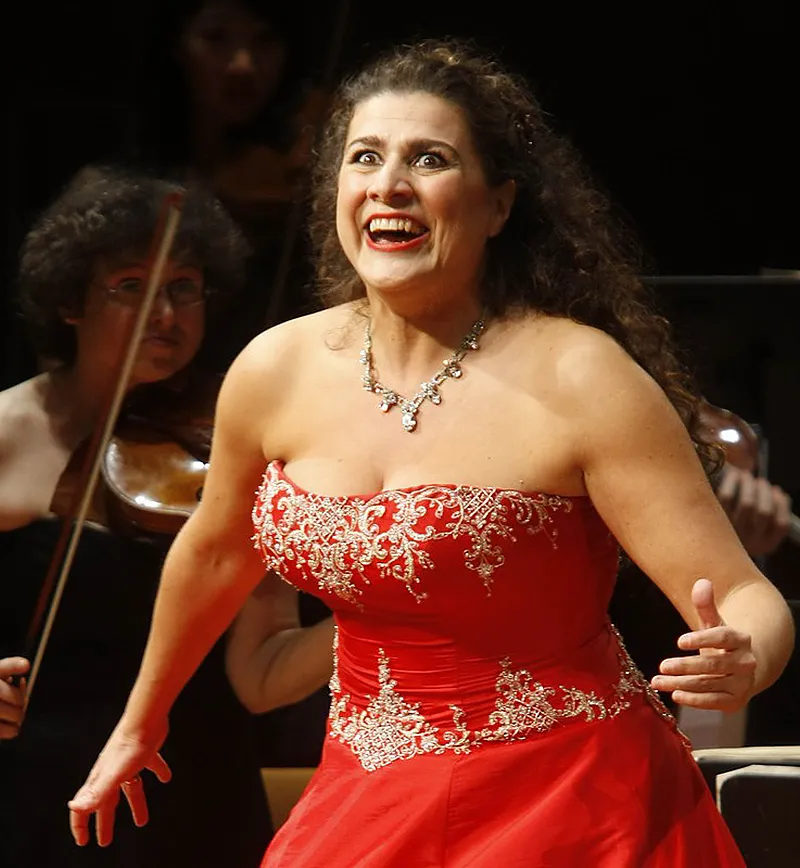
(Photo © 2007: DAVIDS/Sven Darmer - www.svendarmer.de)
Note: Concert photography is not just about great choreography, elaborate stage set-ups, a sophisticated light show or brilliant dance interludes. It is the portraits of the musicians in particular that are the most popular with viewers.
When stars on stage not only show their professionally rehearsed movements and their face like a rigid "official" mask (usually always smiling the same way), but also honest, unrehearsed emotions, the concert photographer can rightly be proud to have captured a special ("intimate") moment.
After all, music lovers and fans want to see/get to know the real "person" behind the facade.
Figure 7.10: Sunrise Avenue in concert at the ZFR in Bochum on August 27, 2012. The concentrated, pained expression on the guitarist's face reveals the passion with which music is made here. Nikon D4 with 1.4/85 mm Nikkor. 1/1000 second, aperture 2.5, ISO 2500, aperture priority (aperture priority).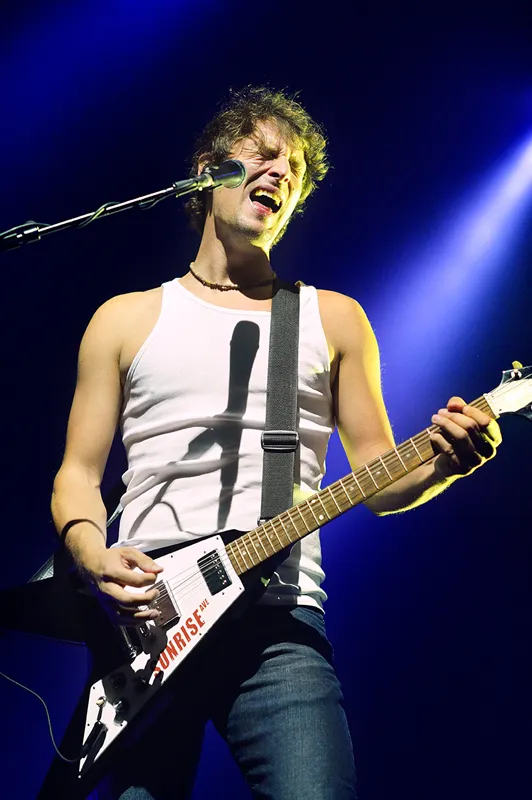
(Photo © 2012: Jens Brüggemann - www.jensbrueggemann.de)
Figure 7.11: Playing drums is hard, sweaty work. Especially when you're sitting directly in front of a (hot) spotlight. The fact that the musicians play with full commitment despite all this is often demonstrated by their facial expressions. It shows the passion that the artists have for their music. Nikon D800 with 2.8/70-200 mm Nikkor at a focal length of 180 mm. 1/400 second, Blender 4.0, ISO 800.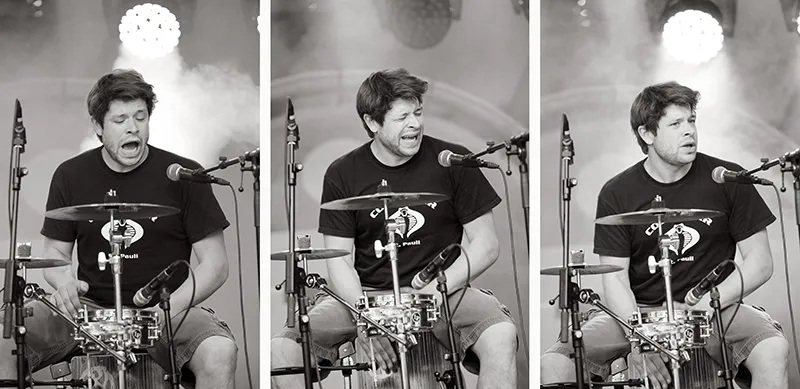
(Photo © 2013: Jens Brüggemann - www.jensbrueggemann.de)
7.5 Capturing eye contact with the artist
Photos of people (this is especially true for photos of celebrities such as musicians) have the most intense effect when the person depicted is looking directly into the camera. The viewer then feels as if the musician is looking at them. Looking directly into the camera is therefore a happy coincidence and is accepted by every concert photographer both joyfully and frantically (such eye contact never lasts longer than a fraction of a second).
However, you should avoid actively demanding a direct gaze, for example by waving at the artist on stage or doing something else to attract attention, as this is distracting for the musicians. If this briefly interrupts or otherwise disrupts the perfect execution of the concert, the photographer will have to deal with security (if the disruption is noticed).
Figure 7.12: It is always a highlight when individual musicians look at me in the camera. This eye contact has a personal touch, and ultimately the musician is looking directly into the eyes of the viewer. The surprised and delighted expression on this artist's face resulted from the fact that I had used my artfully painted Nikon D4 with a suitably painted lens for this concert (you can find photos of this at www.pimpyourcam.de). Nikon D4 with 1.4/85 mm Nikkor. 1/1600 second, Blender 2.0, ISO 2500.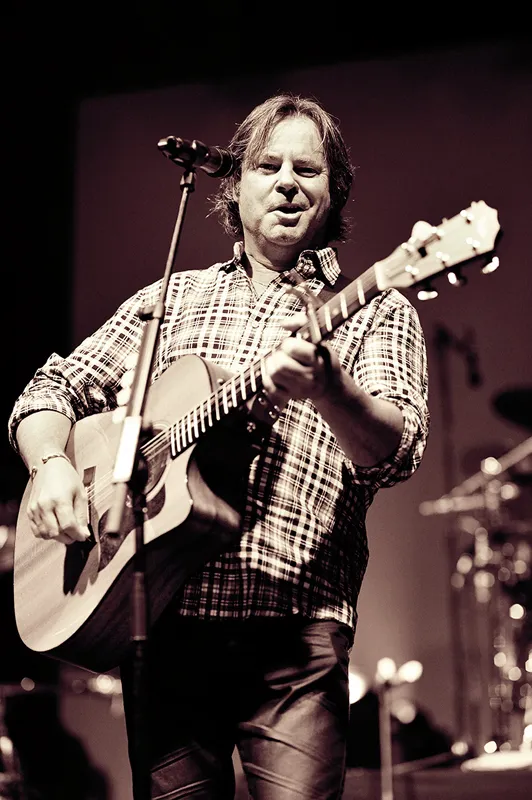
(Photo © 2012: Jens Brüggemann - www.jensbrueggemann.de)
Figure 7.13: Singer Roger Hudgson at his concert in the Admiralspalast in Berlin on May 14, 2013. The musicians on stage have to keep making direct eye contact with the audience in order to see their reactions. It sometimes happens that their gaze touches individual photographers. Canon EOS-1D X with EF 2.8/400mm. 1/250 second, Blender 2.8, ISO 2,500.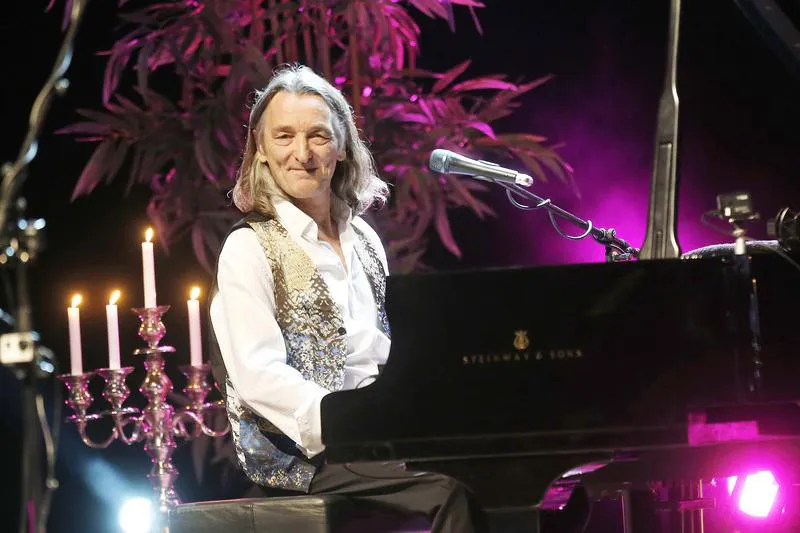
(Photo © 2013: DAVIDS/Sven Darmer - www.svendarmer.de)
Note: If you have the opportunity for one of the musicians to look at you in the camera, make sure you capture this moment, even if not all the "ingredients" of the photo are perfect. It's better to have an unsuccessful crop or a sub-optimal exposure than to miss the chance to take a photo of the star looking directly into your camera.
7.6 Photographing with fog
Fog and lighting inevitably go hand in hand at concerts. You have to realize that: Light in a dust- and fog-free room is not visible (only when the light falls on an object). The photogenic beams of light that are so typical at concerts would not exist if the fog machine(s) were not always doing their job. Only then does the light really come into its own! In practice, this means that we photographers are dependent on the fog (in order to have effectively lit stages), but on the other hand we have to make sure that the fog doesn't get in front of the musicians and block our clear view of the artists.
Figure 7.14: Blackmail in concert on July 12, 2013. Portrait of the singer at the last second: When the fog sets in and moves in front of the band members, we photographers can only wait and see - until the fog clears again. Here I was just able to take a few shots before the fog blocked my clear view. Normally, a change of singer means that a band has to struggle with acceptance problems among the fans. Not so with Blackmail: Singer Mathias Reetz has been with the band since 2010 and the band ("Germany's best-known indie rock insider tip"; founded in 1994) is livelier than ever, as they proved at the successful Bochum Total open-air festivalin summer 2013! Nikon D800 with 2.8/70-200mm Nikkor with 200mm focal length used. 1/320 second, Blender 5.6, ISO 800.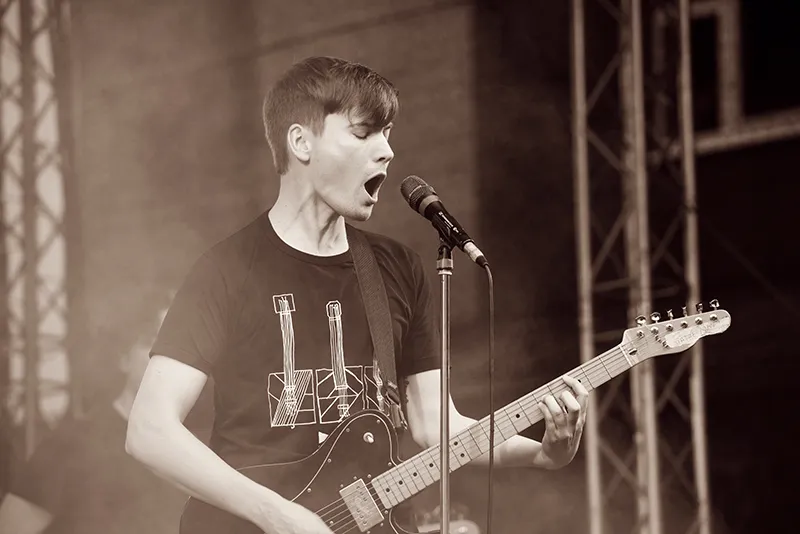
(Photo © 2013: Jens Brüggemann - www.jensbrueggemann.de)
7.7 Showing the origin of the light cones
As already mentioned, the light show at a concert would not be so important as part of the choreography if it were not for the use of fog to make the light cones visible. Photos in which the cones of light can be seen for the most part, but which do not show the origin of the lights, appear "unfinished" and "imperfect".
The viewer (unconsciously) expects to see the spotlights as the point of origin in addition to the cones of light. So pay attention to this in your image composition!
Figure 7.15: It looks unattractive if the light cones are not depicted from their origin (the light source). When photographed cropped, they appear somehow "disturbing". Of course, it is never possible to show all the spotlights as the origin of the light cone, but you should at least try for the most important (strongest) ones. Nikon D3S with 2.8/24-70 mm Nikkor at a focal length of 28 mm. 1/500 second, aperture 2.8, ISO 5,000. Blender priority (aperture priority) with spot metering.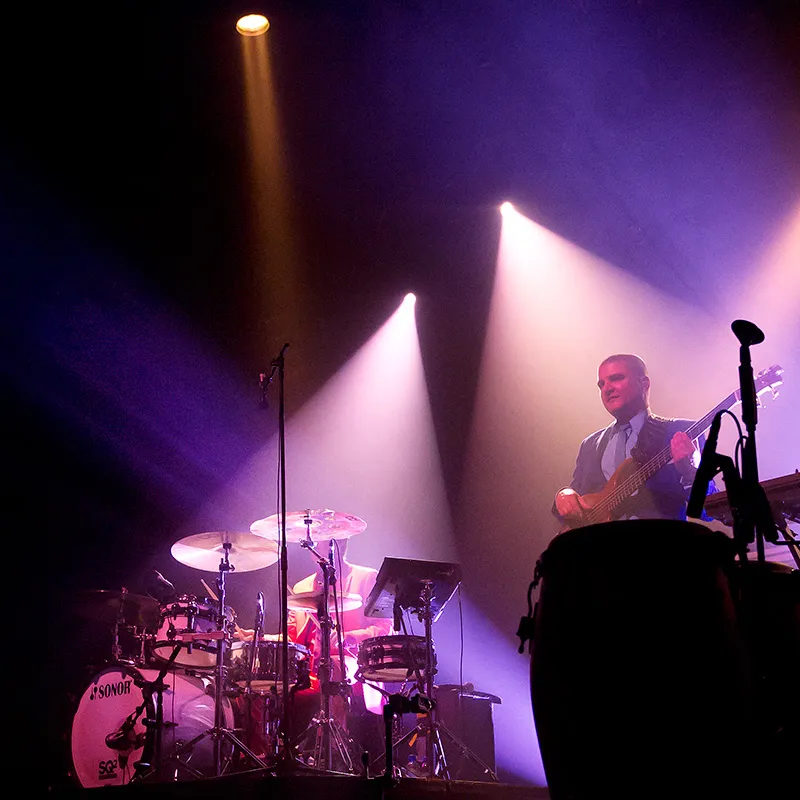
(Photo © 2010: Jens Brüggemann - www.jensbrueggemann.de)
7.8 Orienting the image composition (also) on the lights
If you don't just want to document the concert, but also want to be creative, you can't avoid thinking about where individual band members should be photographed, for example. To do this, it is not always necessary to leave your own position. Often a small change in the shooting angle is enough to show the artist directly in front of one of the cones of light, for example.
These small changes in perspective (usually a sideways movement of the upper body is sufficient, while maintaining the shooting position) are all the more efficient the closer the musician to be photographed is to the stage in front of us.
If the person to be photographed is further away, however, we need to change our position.
Figure 7.16: The H-Blockx (here with singer and band founder Henning Wehland in front of the spotlight cone) at their concert on August 31, 2010 at the ZFR in Bochum/Witten. Nikon D3S with 2.8/24-70 mm Nikkor at a focal length of 70 mm. 1/640 second, Blender 2.8, ISO 6,400.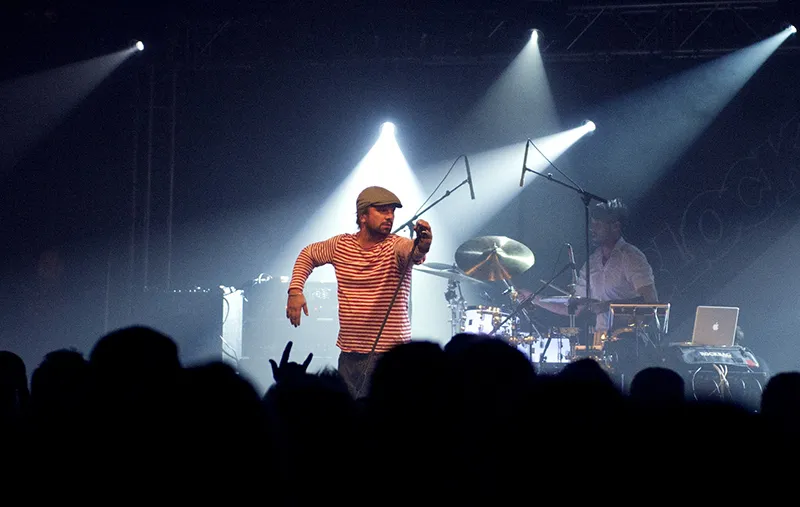
(Photo © 2010: Jens Brüggemann - www.jensbrueggemann.de)
7.9 Don't forget the group photo of the band
It is not easy to realize, but nevertheless almost essential to include all band members in a (group) photo.
Often only the "front men" or "front women" of the bands are photographed by the press photographers. At this point in the press pit, directly in front of the star, there is always a correspondingly dense crowd and jostling for the best photo position.
Nevertheless, the photos of the entire band also have their special value, and not just when it comes to new line-ups. So try to take at least one successful (full) band photo at every concert!
In terms of design, this is always a challenge, as the individual musicians do not necessarily perform in rows (exception: Kraftwerk, for example ; but also many boy groups and girl groups, where the dance choreography requires a certain order during the performance).
Figure 7.17: Many groups have 1 or 2 main members, while the other musicians change from time to time (example: BAP). It is usually enough to photograph the front man. Photos of other band members (or guest musicians) cannot usually be sold (to editors etc.). However, there are bands where you should try to photograph all the members, preferably in a single photo. The Temptations (here at the concert in Berlin on November 2, 2007) are certainly one of them, even if their original line-up from the founding year 1960 has long since disappeared. The 2007 European tour featured Otis Williams (the only founding member), Ron Tyson Terry Weeks, Walter Herndon and Bruce Williamson. Incidentally, The Temptations were inducted into the Vocal Group Hall of Fame in 1999.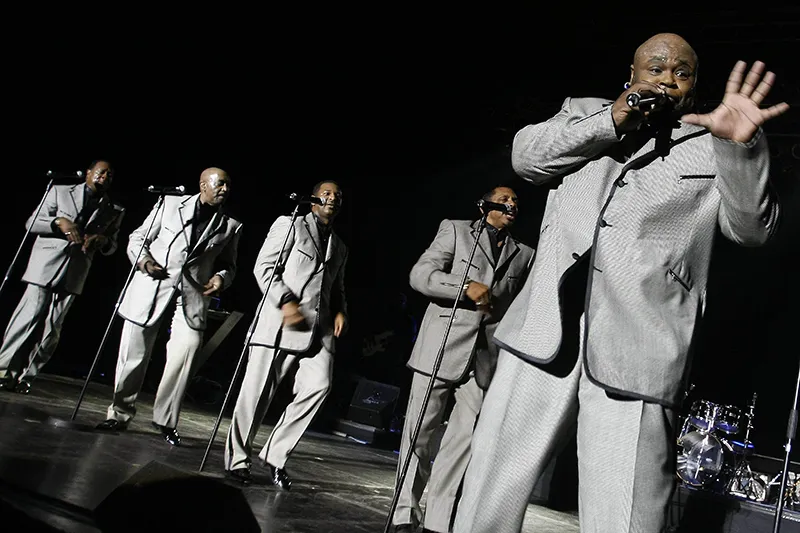
(Photo © 2007: DAVIDS/Sven Darmer - www.svendarmer.de)
Figure 7.18: When the group members move as fast as they do in Culcha Candela (here at their concert on August 20, 2011 at the Zeltfestival Ruhr in Bochum/Witten), it's not easy to take a photo where all 6 band members are in it (and preferably not covered by other musicians/dancers). Their current line-up consists of Johnny Strange, Itchyban, Larsito, Mr. Reedoo, Don Cali and DJ Chino (on the back right of the photo). Nikon D3S with 4.0/24-120mm Nikkor with 24mm focal length used. 1/400 second, Blender 4.0, ISO 3,200.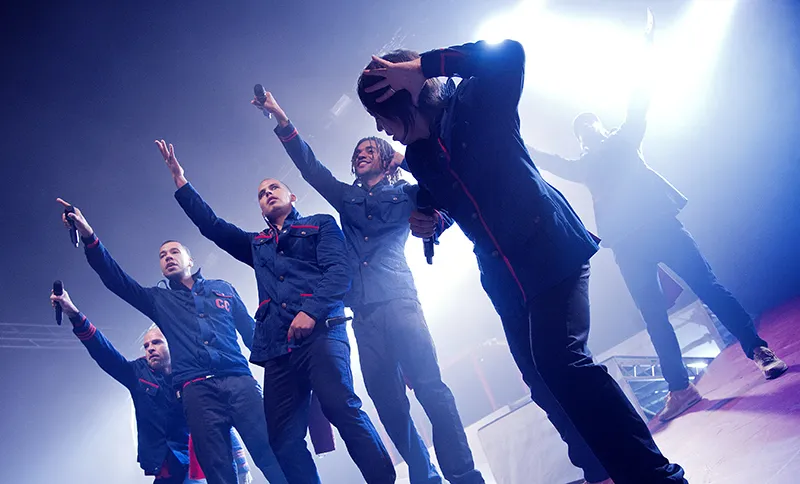
(Photo © 2011: Jens Brüggemann - www.jensbrueggemann.de)
Note: At many concerts, the band says goodbye at the end by hooking themselves together and bowing to the audience in a row. An ideal motif for a photo of the whole band. However, it will only be possible to photograph the last songs in exceptional cases (for example at the "umsonst-und-draußen-Festivals"). The rule at concerts is still that we photographers are only allowed to take photos during the first three songs.
7.10 And don't forget the drummer either
One band member is often forgotten by photographers: the drummer! This is probably because he sits behind his "shooting gallery" the whole time during the concert and, unlike the other band members, has no opportunity to push himself into the foreground on stage. Drummers do their work in a concentrated and effective manner - usually without a "show" (except for impressive drum solos).
Most of them - in full physical action - are always photogenic, which is why you should always make sure to take photos of these important band members when photographing them in concert.
Figure 7.19: The drummers are among the least photographed band members. No wonder, as they are almost always "hiding" at the back of the stage. Here I was able to catch drummer Sami Osala from Sunrise Avenue (Finnish rock band, who also have pop songs and ballads in their repertoire) in full swing (concert on August 27, 2012). Nikon D4 with 1.4/85 mm Nikkor. 1/250 second, aperture 2.2, ISO 3,200. Aperture priority (aperture priority).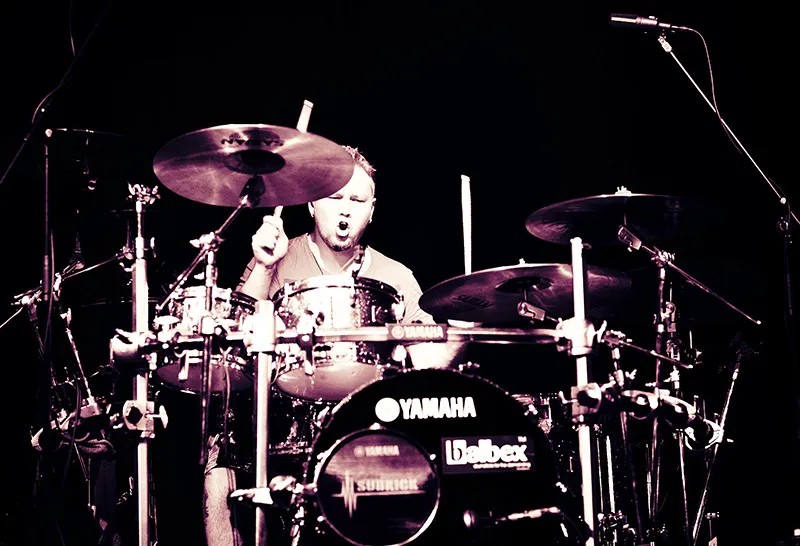
(Photo © 2012: Jens Brüggemann - www.jensbrueggemann.de)
